Understanding Canary Flight: Anatomy, Patterns, and Care
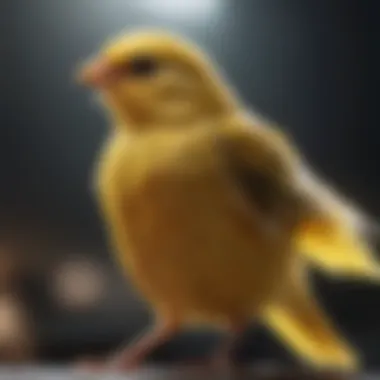
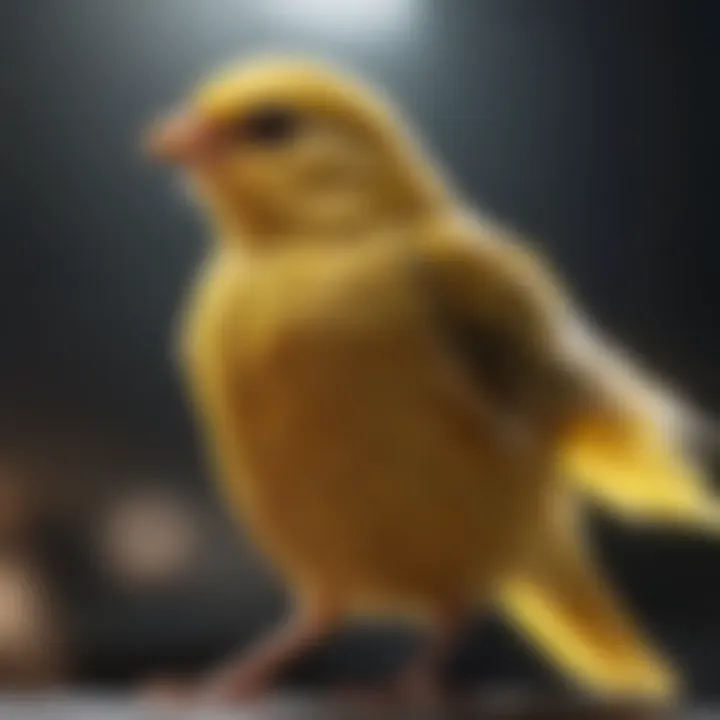
Intro
Understanding the intricate details of canary flight involves recognizing the delicate balance of anatomy, environmental factors, and proper care practices. Canaries are remarkable little birds, each possessing unique characteristics that influence their flight capabilities. This piece serves to elucidate their anatomical framework and the essential attributes inherent in their flights. Moreover, considerations for the habitat can significantly affect their wellbeing and performance.
The anatomy of a canary, particularly its wings and muscles, plays a critical role in defining how gracefully they can navigate the air. Given their small stature and lightweight bone structure, canaries embody an impressive capability for agility. Their flying patterns often vary from short bursts to prolonged glides. However, the pleasant posture of flight is occasionally hampered by several external factors, notably including cage confinement and limited opportunities for exercise.
In this exploration, attention will be duly given to the appropriate routine to promote a healthy living environment, emphasizing daily care, nutrition, health management, and enriching activities. Availing these factors can significantly enhance your canary’s flying experience and emotional wellbeing, affirming a life full of vibrancy for these unique companions.
Care Tips
Daily Care Routines
Effective care routines are paramount to the well-being of your canaries. Daily activities should include monitoring their behavior, feeding them a right diet, and ensuring clean living conditions.
- Change water daily.
- Remove uneaten food from cage.
- Observe for any behavioral changes that might indicate health issues.
- Spend time engaging with them to foster social bonds.
Cage Setup and Maintenance
A proper cage provides more than just shelter; it's an essential element in their lifestyle. Ideal cages for canaries should be spacious, allowing them room to move and, if possible, fly short distances.
- Use bars spaced appropriately to prevent escape.
- Add perches of varying sizes and textures to promote foot health.
- Include safe hiding spots.
Maintenance of the cage is crucial. Cleaning should be thorough and regular. This can include disassembling the cage parts, washing them, and replacing any worn accessories.
Hygiene and Cleaning Practices
Maintaining hygiene for your canaries involves not just the cleanliness of the cage but also their personal health care. This means effectively monitoring for signs of droppings that can lead to unhealthy waste buildup.
- Weekly scrub-down to disinfect cages and perches.
- Use bird-safe cleaning products.
- Minimum bathing intervals should be scheduled for optimal feather health.
Seasonal Care Adjustments
Seasons dictate more than just temperature; they affect the general health and mood of canaries. Special care methods should be employed during extreme changes in environment.
- In Winter, ensure no drafts in the cage.
- Increase humidity in dry seasons.
By adapting daily routines based on seasons, you can help your feathered companions lead comfortable lives.
Behavioral Insights
Understanding canary behavior is crucial for their communication and overall engagement. Observations boost bond strength between owner and pet.
Understanding Bird Body Language
Canaries express many emotions through body language. Things to watch include:
- Raised feathers could indicate nervousness or frost.
- A bobbing head may be a sign of excitement or curiosity.
Common Behavioral Issues and Solutions
Sometimes, small issues arise in behavior. Common concerns include lethargy, excessive squawking, or aggression towards others. Each can stem from adjusting comforts or unbalanced diets.
Solutions must be investigated carefully to alleviate the moods of canaries.
Positive Reinforcement Techniques
Using positive reinforcement aids growth in behaviors you'd like to promote. This can include accommodating playtime for focus exercises, training sessions emphasizing rewards, and other significant moments of positive interaction.
Social Interaction Needs
Canaries fare well in sociable environments, which can make a large difference in their emotional states. Active engagement often results in happier, healthier birds that exhibit normal behavioral patterns.
Strengthening these insights provides a multifaceted understanding of nurturing canaries effectively.
Nutrition Guides
Nutrition plays a vital role in maintaining the health that underpins flight capabilities. Certain food types matter.
Essential Diet Components
The foundation of a canary's diet appears within the optimal proportion of seeds, fruits, and greens. Canaries often favor what is accordingly nutritious in their view.
- Leafy greens for vitamins.
- Soft foods in addition to regular seeds supplement vitality.
Safe and Toxic Foods
Awareness of safe and toxic food items is crucial when caring for canaries.
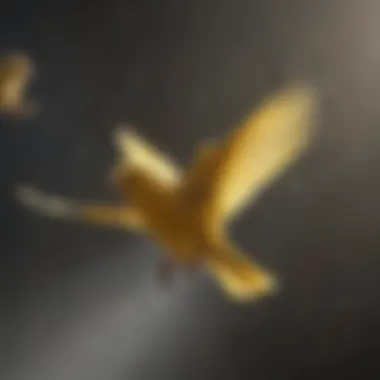
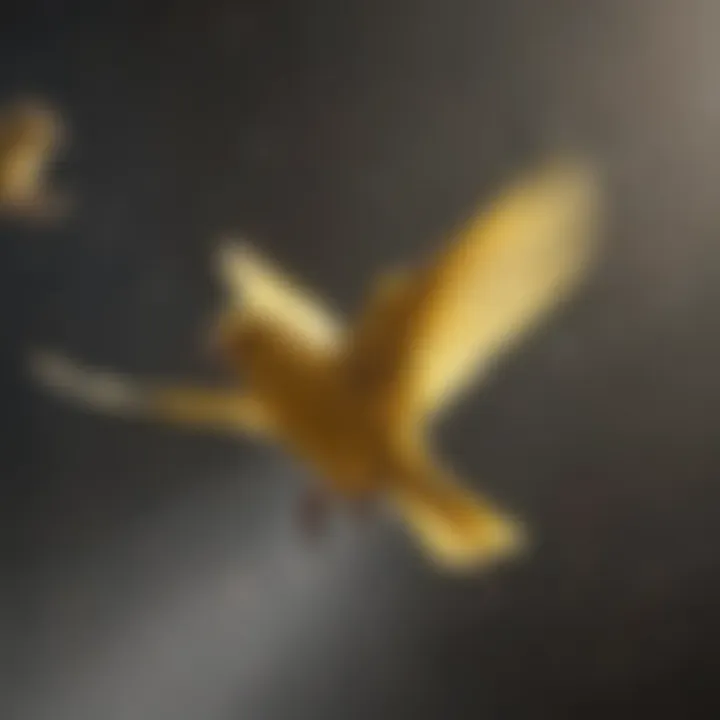
Common safe items include:
- Spinach
- Carrots
Avoiding avocado, chocolate, and caffeine will ward off health complications.
Supplements and Treats
Occasional use of supplements and treats lends additional vigor to the canary's diet. Specifically, utilize calcium and vitamin A additives suited for these small companions to boost flight and overall health.
Feeding Strategies for Different Species
While canaries share similar diets, certain types require different focuses on nutrition. Breeders should account for condition, maturity, and special needs due to age or health conditions. Adjustments ensure balanced nourishment facilitable for each life stage you achieve as a caregiver,
Continuing this nutritional narrative will ensure optimal development geared toward healthy canary flight and activity.
Wellness and Health
Careful health management channels efforts to identify irregularities within your birds promptly.
Routine Health Checkups
Regular veterinary visits accompany general husbandry. Keeping vaccinations updated affords necessary safeguards against contagious diseases.
Identifying Symptoms of Illness
Awareness of common symptoms reflects an owner’s readiness to act. Characteristics requiring attention can encompass weight loss, lack of activity, or fluffing feathers. Note how changes in patterns reveal much about underlying health status.
Preventative Care and Vaccinations
Administering preventative healthcare includes appropriately scheduling vaccines and understanding corresponding avian leisures dictated by climate. Evaluating changes in diets prevents medical conditions.
Mental and Emotional Well-being
Mental engagement through interaction and enrichment substantially affects emotional canary health. Providing consistent contact helps establish their security, fostering comfort and nurturing moods.
Enriching Activities
Finalizing their care regimens is bolstered by engaging activities designed to promote skills associated with flying.
Toys and Playtime Ideas
Interactive toys keep minds sharp and promote physical action. Stuffed fringed toys cater specifically to curious canaries while ropes can flex exercise segments.
Training and Tricks
Canaries relish training opportunities too. Teaching birds through incremental steps assembles inferences focal tallies towards their complimented learning.
Outdoor Activities and Interaction
Bringing canaries outdoors for safe exploratory sessions enlarges their enjoyment of varied zones and airspace use while encouraging confidence.
DIY Projects for Mental Stimulation
Homemade engage activities foster adjustments stimulating canaries’ problem-solving skills efficiently. Construction projects improvised cleverly kit native curiosity.
By fostering a holistic approach on care, behavioral audits, dietary engagements, mindfulness in health dynamics, and enriching experience essential selection through vital actions, we can nweta limits redirect씅 benefit while deepening harmony with our cherished canary fly experiences.
Preamble to Canary Flying
Canary flight, a natural trait stemming from their evolutionary background, plays a significant role in their wellbeing. Understanding the factors surrounding this behavior is crucial for pet bird owners and enthusiasts alike. The ability to fly affects not only the physical health of canaries but also their mental stimulation and social needs. Facilitating flight can enhance their overall enjoyment of life, preventing many behavior-related issues.
The Significance of Flight for Canaries
Flight serves various essential purposes for canaries. Firstly, it caters to their instinctual behaviors. Canaries, in the wild, rely on flight for foraging, the escape from predators, and social interactions. These same instincts linger in domesticated canaries, highlighting their natural need for space and movement.
Physically, flight allows canaries to exercise their muscles and maintain healthy cardiovascular systems. When they are permitted to fly, their wings and legs develop in strength. This activity, in turn, reduces the risk of obesity and its related health problems. Moreover, when canaries engage in free-flight, they engage in behaviors that support their mental health by allowing freedom, flexibility, and a variety of experiences. Being trapped in a confined space can lead to stress and an array of negative behaviors.
Through odyssey of flight, canaries can express certain behaviors. The act of flapping wings is inherently gratifying to them, closely tied to their identity as avians. Providing them with the opportunity to engage in such natural behaviors fosters a more enriched life.
Reasons Canaries May Avoid Flight
Understanding why some canaries may avoid flying is key to ensuring their health and happiness. There are several distressing reasons that canf contribute to this behavior.
One significant issue can be the cage environment. A cage that is too small, or lacks suitable perches, may not inspire a canary to fly. The reluctance to fly may also stem from incorrect lighting. Insufficient exposure to natural light can disrupt their natural rhythms and reduce motivation to engage in active behaviors.
Additionally, changes in their health—such as illness or physical injury—can hinder their flying ability. Canaries in this situation need extra attention and care from their owners. Stress factors like loud noises or the presence of predators, even nearby pets, can lead to adversity towards flying. An understanding of this aspect can help owners to create a more nurturing environment.
Lastly, age and psychological factors may impact their choice to fly. Older canaries naturally exhibit reduced exploratory behavior. While younger birds are typically more active, some may struggle with confidence. If a canary experiences situations that elicit fear or lack encouragement, it may lead to avoidance behavior.
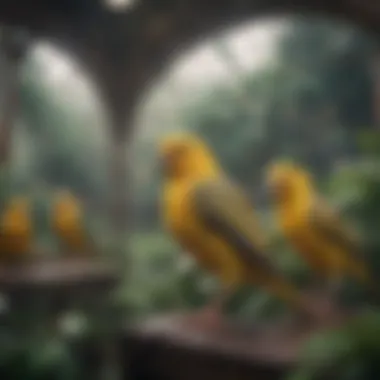
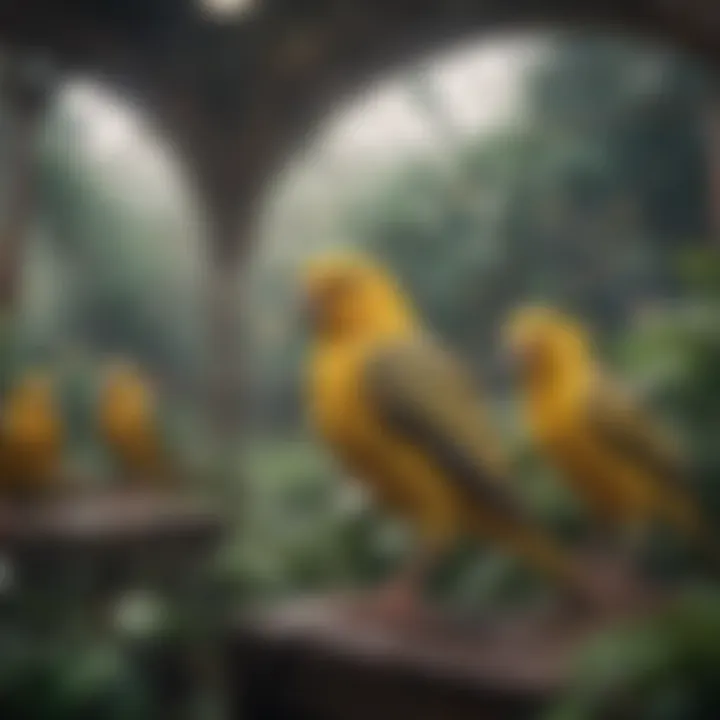
Recognizing these factors permits a proactive approach to enhancing a canary's willingness to fly. A mindful environment designed around these topics will greatly improve their wellbeing and happiness.
Anatomy of Canaries and Their Flight Mechanics
The anatomy of canaries plays a crucial role in their ability to fly effectively. Understanding their physical structure offers insight into how canaries navigate their environments and perform in flight. Specific aspects of their anatomy directly contribute to both their power and agility. This section will explore avian anatomy and the unique wing structure of canaries, highlighting how these factors affect their flying capabilities.
Understanding Avian Anatomy
Canaries are small songbirds belonging to the finch family. To comprehend flight, one must focus on several key anatomical features:
- Skeletal Structure: The lightweight bones of canaries reduce overall body mass, essential for flight. Unlike mammals, birds possess hollow bones, making them strong yet light.
- Muscle Composition: Flight muscles are crucial. Breast muscles provide the power needed for wingbeats, while other muscles assist with stability and maneuverability during flying.
- Respiratory System: Birds have a highly efficient respiratory system, enabling the delivery of ample oxygen during flight activities. The unique air sacs promote continuous airflow, which supports sustained effort in the air.
This anatomical foundation enables canaries to execute impressive feats of aerial performance. It allows them to take swift actions with precision, essential for avoiding predators in their natural habitat. Moreover, proper knowledge of avian anatomy is beneficial for pet owners, allowing them to provide appropriate care and environment for their feathered companions.
Wing Structure of Canaries
The wings of canaries are not only a remarkable feature of their anatomy; they are also the key to their ability to fly. Analyzing their wing structures reveals how this bird utilizes its physical attributes to enhance movement:
- Wing Shape and Size: The broad, pointed wings allow canaries to achieve dynamic lift, aiding in quick ascents and turns. The shape maximizes the surface area, necessary for effective propulsion.
- Flight Feathers: Canaries have specialized feathers on their wings called remiges. These primary and secondary flight feathers create air resistance, providing thrust and stability needed during flight.
- Wing Joints: The flexibly designed wing joints enhance the range of motion, allowing intricate maneuvering. This mobility supports diverse flying styles, from rapid flaps to graceful glides.
Altogether, the wing structure is well adapted for navigating various environments. Those who observe how far canaries can soar will better appreciate how these birds leverage their anatomical features effectively.
Understanding the anatomy of canaries is critical in promoting their health and ensuring they're able to fly effectively in domestic environments.
In summation, both the unique skeletal and muscular structures, along with soft-tissue adaptations, create an effective flying machine. It clarifies that proper care—mirroring natural habitats—will enrich their quality of life and further enhance the flying experience for pet donaries.
Factors Influencing Flight Ability
Understanding the factors that influence a canary's ability to fly is crucial for creating an optimal environment for these birds. Canaries, like any other species, possess unique attributes that dictate their flying capability. Delving into genetic aspects, nutritional needs, and overall health unveils vital components that play a significant role in whether a canary gets airborne.
Genetic Considerations
Genetics play a foundational role in determining the physical attributes of canaries that contribute to their flying abilities. Different breeds of canaries showcase distinct flight characteristics and athletic capabilities. For instance, song canaries often exhibit shorter wingspans and body shapes that are more suited for particular types of singing rather than prolonged flights. As a result, when selecting pet caanaries, enthusiasts should research the breed's flight potential.
Canaries engineered specifically for performance often demonstrate superior agility and endurance, thanks to selective breeding practices.
DNA variations can affect muscle strength, bone density, and wing proportions. These genetic factors may hinder or enhance flight capabilities accordingly. In some cases, genetic disorders can lead to reduced flight ability, promoting a need for careful evaluation when selecting breeding partners.
Diet and Nutrition
Proper nutrition is vital to promoting strong muscles and adequate wing development, both essential for a canary's ability to fly. A diet rich in proteins, vitamins, and minerals will support not only solid bone health but also muscle strength.
Key components of a nutritious diet for canaries include:
- High-quality seeds (like millet and canary seed)
- Fresh fruits and vegetables (e.g., carrots, leafy greens)
- Special supplementary vitamins (like calcium or vitamin D3)
Canaries also greatly benefit from protein sources like boiled eggs or specific formulations designed for birds, enhancing their overall strength and vitality. It’s important for canary owners to be aware that deficiencies in nutrients can lead to a lack of energy and willingness to fly. Inadequate fat content could limit a bird's longevity period aircraft.
Health and Wellness Implications
The general health and welfare of canaries are paramount for optimizing flight capabilities. Various illnesses or conditions may severely influence a bird's eagerness to fly. Problems like obesity, respiratory issues, or even feather-related disorders can deter canaries from flying, affecting their quality of life. A pet bird that is overweight might struggle to attain the necessary lift, leading to decreased mobility or activity.
Regular assessments and consultations with avian veterinarians can aid in maintaining a canary’s health, allowing for early detection of any concerns. Practices such as targeted flying exercises can assist in building strength, enhancing overall wellness. Pay close attention to:
- Symptoms indicative of illness (e.g., lethargy, abnormal droppings)
- Routine health medical check-ups
- Available vaccinations or preventative measures for common avian diseases
Flight ability in canaries transcends beyond sheer physicality. A holistic understanding of genetic influences, dietary needs, and health considerations form a solid foundation for ensuring that these birds enjoy flying consistently. By carefully weighing these elements, bird owners can significantly enhance the flying experience for both themselves and their canaries.
The Role of Environment in Canaries' Flight
The environment plays a crucial role in the flight abilities of canaries. Understanding how various environmental factors affect their capacity to fly is essential for bird owners. Proper consideration of these elements can maximize the well-being of canaries and enhance their flying experience. This section focuses on two primary aspects: cage design and space requirements, along with the influence of lighting conditions.
Cage Design and Space Requirements
A well-designed cage is vital for a canary's health and flying habits. Canaries need space to stretch their wings and practice flying. An inadequately sized cage can restrict movement, potentially impacting their physical health. The layout of the cage should allow for horizontal flight, as canaries generally prefer to fly laterally, covering distances rather than ascending quickly.
When selecting a cage, consider the following:
- Size: The larger the cage, the better. A width of at least 24 inches is recommended. This allows room for horizontal flight.
- Configuration: Multi-leveled cages can offer more areas for exploration. They should include platforms and spaces where birds can hop and flutter comfortably.
- Bar Spacing: Accurately measured bar spacing should prevent escape and injury. Ideally, gaps should be small enough to keep tiny birds in and avoid accidents.
- Obstacles: Avoid clutter in the cage. Shy canaries may become stressed in cramped quarters.
By designing a suitable environment, bird owners can ensure holistic support for the flying experience of their pet canaries.
Influence of Lighting Conditions
Lighting plays a pivotal role in a canary's flight behavior. Since canaries are diurnal animals, they thrive with consistent access to natural light. Adequate lighting affects myriads, such as mood and activity level. Here are some pertinent points regarding lighting conditions:
- Natural Light: Position the cage strategically near a window to provide fresh air and natural sunlight. This can bolster canaries' health and stimulate flying instincts.
- Artificial Lighting: If natural light is limited, use full-spectrum light bulbs to simulate daylight. These bulbs help maintain normal circadian rhythms and provide Vitamin D, which is critical for bone health.
- Daylight Hours: Ensure a consistent day-to-night routine within desired limits. Canaries benefit from approximately 10-12 hours of light and 12-14 hours of darkness.
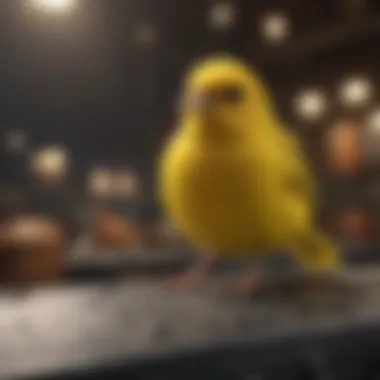
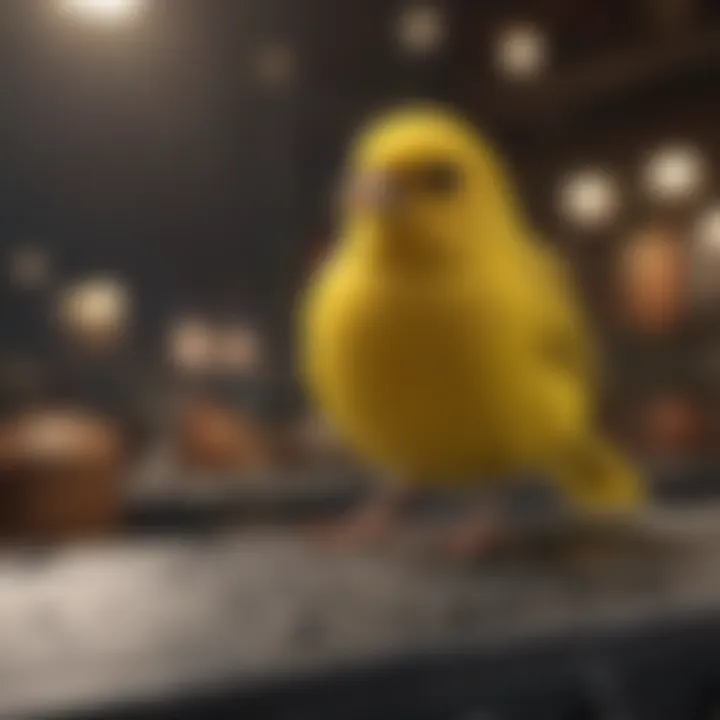
A suitable light environment not only encourages exploration but also enhances overall well being, contributing to better flight capacity.
Ultimately, the surrounding environment profoundly influences a canary's willingness and ability to fly. Owners should aim for both space and light that meet their pet’s needs to foster a gratifying flying experience.
Training Canaries for Flight
Training canaries for flight is crucial in enhancing their overall well-being. Many owners may overlook the role that flight plays in the life of a canary. Proper training can lead to a happier, healthier bird while cultivating a bond between the bird and the owner. Training helps develop their muscles and coordination, allows them to explore their surroundings better, and can even prevent behavioral issues such as boredom and fear. Therefore, understanding effective training approaches will significantly benefit both the canaries and their owners.
Basic Training Techniques
Establishing a solid foundation in training requires consistent effort and understanding of a canary's natural behavior. Basic training techniques are designed to promote flight fitness and to build trust incrementally. Here are some effective strategies:
- Familiarize with the Environment: Let your canary explore its cage space. This allows the bird to assess where it can land safely.
- Gentle Encouragement: Use your finger or a small perch to coax the canary into flying short distances initially. The key is to be patient.
- Target Training: Utilizing a target stick can encourage your canary to fly towards it. Reward the bird with positive reinforcement to reinforce successful flights.
- Flight Recall Exercises: Get your canary accustomed to flying back to you. Start in a safe confinement area, calling its name. Provide treats upon return.
These techniques offer a structured approach to making flight enjoyable and less stressful for the canary. As the bird becomes familiar with flying, you can introduce variations of distance and angles gradually, always considering its comfort level.
Advanced Flight Exercises
Once the basic training techniques have laid the groundwork, you can progress to advanced flight exercises that encourage agility and confidence in the air. Advanced exercises not only add variety but also challenge your canary physically and mentally. Some advanced flight activities include:
- Obstacle courses: Set up simple obstacles in their flight area, using perches and toys. This stimulates problem-solving and keeps the canary active.
- Free Flight Sessions: In a secure environment, allow the canary to fly freely for short durations. This free flight allows an opportunity for natural behaviors to emerge and builds strong muscles.
- Interactive Play: Offer interactive toys designed for flight. These toys encourage canaries to hop from one perch to another while keeping their flying skills sharp.
- Group Flying: If you own multiple canaries, supervised flight sessions with other birds can encourage social interaction and further enhance flight capabilities.
Success in these activities needs careful observation for signs of stress or discomfort.
Common Flight-related Health Issues
Flight is a natural behavior for canaries, reflecting their physiology and playfulness. Understanding the common health issues related to canary flying is crucial for ensuring their well-being. Problems with flight can stem from various factors, including physical attributes, injury, and environmental stressors. Awareness of these potential issues not only helps in maintaining the overall health of pet canaries but also enhances their flying experience.
Identifying Flight Problems
Identifying flight-related problems in canaries starts with observing their daily behavior. A canary that flies well typically appears energetic and engaged in its surroundings. If you notice changes in your bird's flight patterns, it is essential to assess various potential health issues. Common indicators may include reluctance to fly, unsteady flight, or persistent collisions with objects. These signs can indicate health concerns like feather plucking, muscular weakness, or conditions affecting the respiratory system.
Some specific things to watch for include:
- Lethargy: A lack of activity may suggest underlying health issues such as respiratory infections or viral diseases.
- Clipped Wings: Avoid wings assigned by pet stores or breeders, as they might lead to poor feather development.
- Changes in Weight: Underweight or overweight birds can experience flight difficulties due to limited energy or reduced muscle mass.
Being able to warn about these problems can lead to early treatments and a better life for your canary.
Preventive Measures for Health Maintenance
Proactive measures can play a significant role in minimizing flight-related health issues. Supporting a canary's overall health promotes not only better flying but also provides a fulfilling life for the bird. Here are some simple yet effective steps owners can consider:
- Regular Veterinary Check-Ups: Ensuring that a veterinarian assesses the bird annually helps catch potential issues before they escalate.
- Balanced Nutrition: A diet rich in seeds, green leafy vegetables, and occasional fruits ensures that the canary gets necessary vitamins and minerals.
- Space for Exercise: Adequate space for flight and activities is critical; canaries need a spacious cage or during outdoor time in a controlled environment.
- Engaging Environment: Adding rich environment with toys, perches, and climbing structures keeps your canary active and prevents boredom.
It is essential to provide continual care and observatory habits around your canary's behavior and schedule health protocols in your geographic seasons to encourage their flying ability.
Maintaining awareness about flight-related health issues will ensure your canaries remain active, happy, and flying well.
By investing time in understanding and addressing these health considerations, canary owners foster a more enriching and rewarding experience for their feathered friends.
Enrichment Activities to Encourage Flying
Enrichment activities play a critical role in promoting a canary's flight. They cater to physical and mental stimulation gathered from their environment. Canaries, by nature, need activities that encourage instinctual behaviors. Engaging in flight is essential for their health and well-being. Without proper enrichment, canaries may become inactive and face problems like obesity or behavioral issues. Therefore, introducing enrichment activities is needed for owners aiming to enhance their pet's flying experience.
Creating a Stimulating Environment
A stimulating environment is fundamental for encouraging canaries to fly. This can be achieved through careful setup and considerations.
- Cage Size and Placement: Ensure that the cage is spacious enough for flapping and moving around. A larger cage can facilitate easier flights. Basket-style structures can give canaries room to soar.
- Perches at Different Heights: Strategic placement of perches can stimulate the desire to fly. Canaries feel encouraged to explore their vertical space. Using perches of various materials helps to provide additional grip, allowing them to navigate easily.
- Natural Elements: Consider introducing some natural branches into the aviary. They provide not only surfaces for roosting but also imitate their natural habitat experience, motivating flight.
- Bird-safe Plants and Greenery: The integration of certain plants can enhance a canary's surroundings. Remember to choose plants that are non-toxic. These elements can spark their curiosity, stimulating flights.
- Safety Features: Ensure the environment is secure. Strive for a free around area clear of unknown hazards to encourage roaming. Simple visuals can invite canaries to explore rolling their flights little by little.
Interactive Toys and Games for Canaries
Introducing interactive toys and games is necessary for an enriching flying environment. These activities encourage physical movement while enhancing their curiosity about flying.
- Flight Rings: Install hoops where they must fly through. It not only hones their flying skills but also creates a fun journey when engaged.
- Foraging Toys: These encourage canaries to seek treats hidden within toys or natural hideouts. Seeking their food stimulates their mental faculties and encourages movement.
- Swings and Bars: Movement-focused toys like swings push canaries to fly and balance, allowing some exercise during playtime.
- Mirrored Surfaces: Birds often enjoy their reflection. Mirrors installed in areas can encourage canaries to engage in visual exploration, sometimes leading them to take flight.
- Interactive Games: Such as ring toss or even gentle balls that can be nudged around, maintain entertained and enrich the available activities.
Engaging canaries in these meaningful activities supports their flying behavior, fosters stronger instincts, and ultimately leads to a happier and more active pet. Providing a diverse environment sustains rich experiences when canaries explore their special world.
Culmination: Enhancing the Flying Experience for Canaries
Enhancing the flying experience for canaries holds profound significance, not just for the birds, but also for their owners. Creating an environment that supports and encourages flight contributes to the overall well-being of these avian companions. Canaries, by nature, are creatures meant to soar. Understanding the elements that facilitate or hinder this practice is crucial for any bird owner or breeder.
An effective approach towards improving a canary's flying experience includes three main areas: optimal cage design, routine health checks, and regular interaction through training. Each element serves a unique purpose. Good cage design provides the space needed for physical movement, while health checks ensure that canaries are physically capable of flying. Furthermore, engaging activities can motivate them to explore their flying abilities.
Summarizing Key Considerations
- Environment Matters: Make sure that the surrounding area is safe and open enough for flight.
- Supportive Health Conditions: Regular veterinary visits can help detect and prevent issues that may cause flight aversion.
- Training and Stimulus: Routine exercises should be implemented to keep canaries agile and comfortable in flight.
- Nutrition and Diet: Offering a well-balanced diet plays an essential role in the overall strength and flight capability of canaries.
The above considerations summarize critical points regarding the provisioning of a supportive flying environment for canaries. Owners should take pride in fostering this essential aspect of their pet’s life, it impacts their happiness and health.
Final Thoughts on Responsible Canary Care
Taking care of a canary encompasses a range of responsibilities that directly influence its flying abilities. Aside from physical health, mental stimulation is also vital. A diverse routine keeps canaries engaged and encourages them to utilize their natural flying instincts.
To wrap up, a compassionate request to bird owners: be observant of your canary’s behavior. This attentiveness enables timely actions if they seem hesitant or concerned about taking flight. Letting them fly in a safe manner instills confidence in their abilities. Overall, enriching their life will enhance their flying acumen. Remember, canaries are not only pets; they enrich our lives with their beauty and patterns. Engaging responsibly with them ensures a delightful avian experience for many years.















